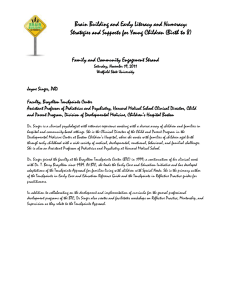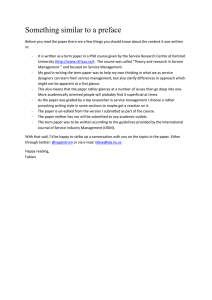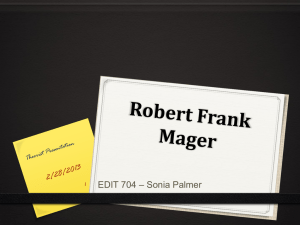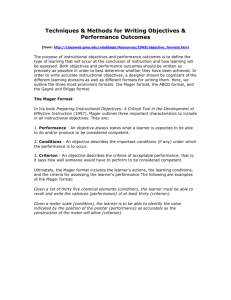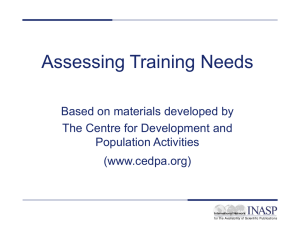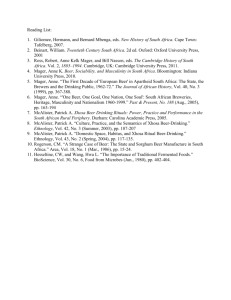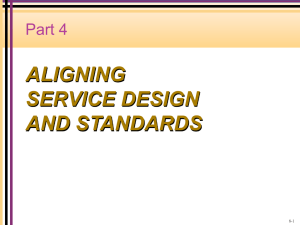Searching for Definitions for Service Design
advertisement
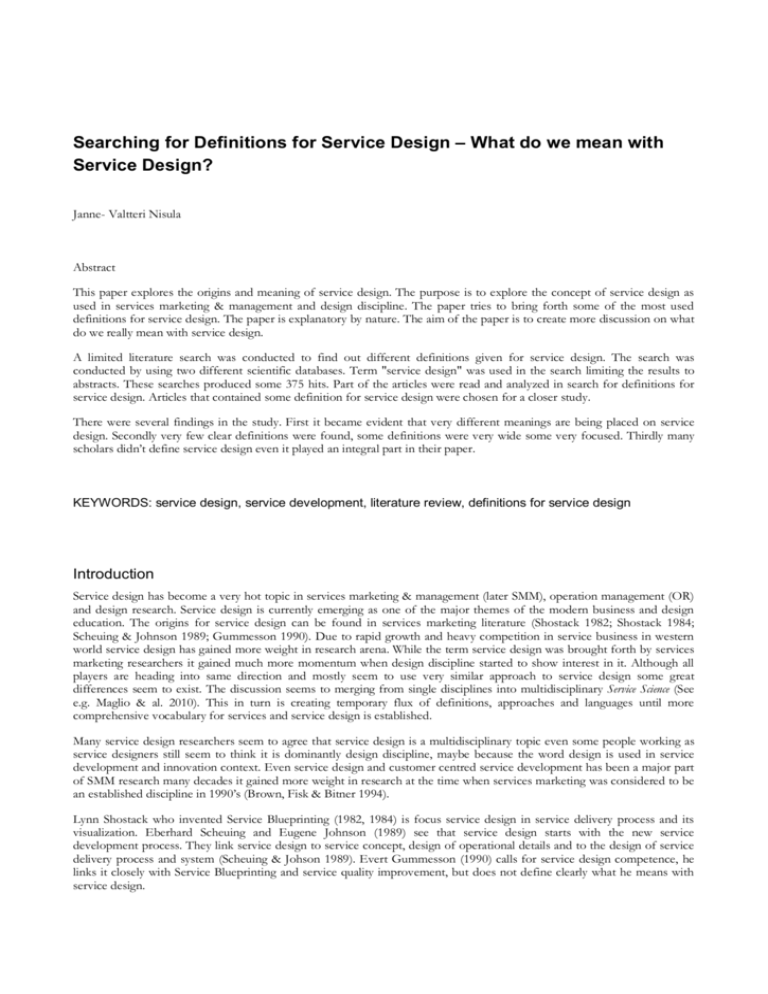
Searching for Definitions for Service Design – What do we mean with Service Design? Janne- Valtteri Nisula Abstract This paper explores the origins and meaning of service design. The purpose is to explore the concept of service design as used in services marketing & management and design discipline. The paper tries to bring forth some of the most used definitions for service design. The paper is explanatory by nature. The aim of the paper is to create more discussion on what do we really mean with service design. A limited literature search was conducted to find out different definitions given for service design. The search was conducted by using two different scientific databases. Term "service design" was used in the search limiting the results to abstracts. These searches produced some 375 hits. Part of the articles were read and analyzed in search for definitions for service design. Articles that contained some definition for service design were chosen for a closer study. There were several findings in the study. First it became evident that very different meanings are being placed on service design. Secondly very few clear definitions were found, some definitions were very wide some very focused. Thirdly many scholars didn’t define service design even it played an integral part in their paper. KEYWORDS: service design, service development, literature review, definitions for service design Introduction Service design has become a very hot topic in services marketing & management (later SMM), operation management (OR) and design research. Service design is currently emerging as one of the major themes of the modern business and design education. The origins for service design can be found in services marketing literature (Shostack 1982; Shostack 1984; Scheuing & Johnson 1989; Gummesson 1990). Due to rapid growth and heavy competition in service business in western world service design has gained more weight in research arena. While the term service design was brought forth by services marketing researchers it gained much more momentum when design discipline started to show interest in it. Although all players are heading into same direction and mostly seem to use very similar approach to service design some great differences seem to exist. The discussion seems to merging from single disciplines into multidisciplinary Service Science (See e.g. Maglio & al. 2010). This in turn is creating temporary flux of definitions, approaches and languages until more comprehensive vocabulary for services and service design is established. Many service design researchers seem to agree that service design is a multidisciplinary topic even some people working as service designers still seem to think it is dominantly design discipline, maybe because the word design is used in service development and innovation context. Even service design and customer centred service development has been a major part of SMM research many decades it gained more weight in research at the time when services marketing was considered to be an established discipline in 1990’s (Brown, Fisk & Bitner 1994). Lynn Shostack who invented Service Blueprinting (1982, 1984) is focus service design in service delivery process and its visualization. Eberhard Scheuing and Eugene Johnson (1989) see that service design starts with the new service development process. They link service design to service concept, design of operational details and to the design of service delivery process and system (Scheuing & Johson 1989). Evert Gummesson (1990) calls for service design competence, he links it closely with Service Blueprinting and service quality improvement, but does not define clearly what he means with service design. William Hollins (1993) was probably the first design scholar to study service design. He starts with TQM thinking and builds an elementary model for service design process while failing to give any clear definition for service design. Unfortunately for the present research these pioneers created no exact definitions for service design in their early articles. There seems to be some communication gap between SMM and design discipline in the area of service design. The gap is slowly getting smaller. More lively discussion on service design between the scholars in both disciplines has emerged in recent years (e.g. ServDes conference). When studying closer the scholarly work in service design one can see some kind of common understanding slowly emerging. Some scholars have made efforts to bridge this gap and find common ground for discussion in service design (See e.g.: Kimbell 2011). Lucy Kimbell (2011) analyses the problem of different disciplines talking about service design with different approach and partly different terminology. She concludes that different players in service design or service development research see service design from a different angle. She argues that there are at least four different approaches to service design and that two of these four have a major difference in their approaches to service design. One is service engineering approach that is based on problems solving with predetermined design of the service and outcome focus. The other is designing for services approach in which design is seen as exploratory enquiry. In this approach it is seen impossible to predetermine the design totally in advance or make the design ever totally complete. (Kimbell 2011) Method A limited literature search was conducted in order to find out common definitions for service design and to find out what kind of differences in service design definitions exist. Search terms “definitions for service design” and “service design definitions” created only four hits in Metalib search system. It searched this term in thousands of different journals. Then a search for term “service design” was executed by using two scientific databases Emerald and Proquest/Abi Inform. The search was limited to abstracts and peer reviewed scientific journals with the extra limitation for subscribed content and full papers. The extra limitations are dependent on the subscriber rights and caused further limitation to the search. This search produced 53 hits in Emerald and 322 hits in Proquest Abi Inform. The amount of hits created a major challenge for this study. It proved to be difficult to find some objective way to search for the definitions for service design. During three long interviews with different informaticians in two universities it became evident that one has to limit the hits and the analysis other some way than by using the search functions in different databases. All the articles found through Emerald search were read and analysed and some of the definitions chosen for a closer study. Proquest/Abi Inform search was limited to only few journals. It is self evident that this explorative and methodologically weak approach left many relevant sources out of this study. Results & analysis Multiple different definitions and very different dimensions were given for service design in the studied articles. Many modifications of service design were found: new service design multilevel service design service system design service process design design of services service concept design services redesign service recovery design service design planning service encounter design These modifications and the loose manner they were used painted a picture of a wild west of service design terminology. All authors who used these modifications used also the term service design. Either the term service design appeared in a more specific context (e.g. service process design) or in a complex and loose context (e.g. multilevel service design). The definitions for service design were gathered in a table (Figure 1). The table consists of four different categories: definition(s), authors, publication date and dimensions. The dimensions category was established because all definitions are multilevel in their approach to service design (like “service concept in service delivery system”). This loose category aims simply to show more clearly the major differences in different definitions. The definitions are not put into any relevance ranking. The order of the table is based on publication date. Definition Author Year Dimensions No clear definition “In service design, we seem to have followed the blueprinting movement but we appear to have ignored the process of design in favor of this descriptive activity and the relationship between important, and often ignored, back-office activities in favor of customer-facing processes.” “..Designing service means defining an appropriate mix of physical and non-physical components.” Johnston R. 1999 Service Blueprinting is seen as the root of service design description but lacking real design approach Goldestein S., Johnston R., Duffy JA. Rao J. 2002 “Service design here refers to the design of facilities, servers, equipment, and other resources needed to produce services. It includes blueprint of service system, specifications, procedures and policies.” Ghosh S., Surjadjaja H. Antony J. 2004 “NSD encompasses the development of tangible and intangible elements of service, not previously offered by the supplier, including “offer development”, i.e. the development of “processes by which the product (or service) is evaluated, purchased and consumed” ..”A wide range of organizational features may be including systems, staff, the physical environment, and organization structure and control. “..The service design framework defines two dimensions continuity of co-production and mutual adaptability characterized by the process of exchanging service/benefit and building relationship involved within service.” “..Planning of the service concept, service process, and service system in manner that enables the value-in-use of the intended service to be realized” Smith A, Fishbacher M. 2005 Service concept as key driver in service design decisions NSD, SD and SI handled as somewhat similar terms Service design planning model linking service strategy to service design Service design focuses on back-end support of service operations Designing facilities, equipment and resources Creates trilogy of services marketing, service design and service delivery NSD with an emphasis of: Development process Organizational structure and control Stakeholder relationships Interaction with final customer/consumer Tung W-F. Yuan ST. 2008 Åkesson M. 2008 “Service design aims at designing services that are useful, usable and desirable from the user perspective, and efficient, effective and different from the provider perspective. It is strategic approach that helps providers to develop clear strategic positioning for their service offerings. Services are systems that involve many different influential factors, so service design takes holistic approach in order to get an understanding of the system and the different actors within the system.” “Design for experiences that happen over time Mager B., Sung T-J. 2011 Clatworthy 2011 Edvardsso B. Design science approach Ecologic symbiosis concept Intelligent design framework of service systems Systematic service innovation Service concept in service delivery system Categories of change: Service encounter and service process Customers as co-creators Effieciency Increased complexity Integration Customer journeys Visualization Services as systems Strategic approach Touchpoints as central part of service and across different touch- points” Figure 1. S. design Touchpoints as reference to service encounter Touchpoints as part of service innovation Modelling services through touchpoints Definitions for service design Some definitions were specific but none of them was rigorous. Some definitions consist of so many different aspects and professional areas that they seem to say service design is everything (like Smith & Fishbacher 2005, Mager & Sung 2011). Some of the definitions were short and limited to few aspects (like Goldstein & al 2002, Clatworthy 2011). The allencompassing definitions seem to take more systematic, complex and holistic view of the whole service production (producer, customer, end-user, networks) while the more compact ones place more emphasis on human experience and focus on single aspects like touchpoints. Ghosh & al (2004) mention facilities, resources, policies and procedures in their definition as integral parts of service design. This definition gives easy access to the terminological cacophony one encounters when exploring the meaning of service design. It raises more questions than it answers. What do they mean with policies and procedures? How do they limit the term resources? Many of the definitions were hard to understand because they were build of different terms (concepts) like service concept, service system and service offering. Each of these terms have many different definitions. Clatworthy (2011) sticks to his guns and creates service design understanding through the concept of touchpoints – he is focused in development and creation of service encounters. He leaves less room for speculation than any other of these definitions. Also Goldstein & al. (2002) give short definition but obscure it by talking about non-physical components. Goldstein & al. (2002) and Åkesson & Edvardsson (2008) link service design to service concept. It is interesting to find out that the definition Mager & Sung (2011) create has similarities with the one Åkesson & Edvardsson (2008) and Smith & Fishbacher (2005) create. Åkesson & Edvardsson (2008) give short but almost allencompassing definition for service design. They see it as integral part of service concept that in turn is part of service system, the service concept includes both customer and providers perspective and tells at least part of the business strategy (Åkesson & Edvardsson 2008). Just by looking at the definition by Mager & Sung (2011) one might think they define service design more or less from a services marketing perspective. The fact that Birgit Mager is widely considered to be the leading expert of service design in design discipline makes this loose similarity interesting. At closer look to their article one sees that they mix service development, services marketing and management and systems thinking, visualization and call this mixture service design. Conclusions It seems to be very difficult to sort theses differences in approach and definition with any accurate and all-encompassing model. The study reveal that there is a urgent need to find a more understandable and commonly accepted approach to service design in order to find more scientific basis for service design research. A lot of brilliant effort is partly wasted when all parties talk to one another with a different language. There are several limitations to this study. The greatest weakness of this paper is methodological. Firstly the search criteria can be criticized for limiting search for only two scientific databases, and then hand picking some from the other rather than reading more relevant amount of articles. Although limiting hits to abstracts is more easily defended. Rather than limit oneself in literature review to predefined search criteria and to mercy of different search parameters in different scientific database and one could have taken a through historical review on the development of the term. This approach might have given more clear picture and and more muscle to the analysis of the term. Secondly no established method for analysing the definitions were used. Thirdly the definitions could have been organized into more comprehensive model like the one Lucy Kimbell (2011) used in her approach. All in all despite these shortcoming one can claim that at least to some degree the paper reaches its goal. There is a short exploration to the term and to different definitions given by various authors of different disciplines. The exploration tells clearly that at least there seems to be some similarities in service design definitions there are also many differences. It also shows that some definitions are build so wide and multilevel that they rather disrupt the term than clarify it. References Åkesson, M. & Edvardsson, B. (2008), "Effects of e-government on service design as perceived by employees", Managing Service Quality, vol. 18, no. 5, pp. 457-457-478. Brown, S., Fisk R. & Bitner M. (1994). The Development and emergence of services marketing thought. International Journal of Service Industry Management, Vol. 5 No. 1, pp 21-48 Clatworthy, S. (2011), "Service Innovation Through Touch-points: Development of an Innovation Toolkit for the First Stages of New Service Development.", International Journal of Design, vol. 5, no. 2, pp. np-np. Ghosh S., Surjadjaja H. & Antony J. Optimisation of the determinants of e-service operations. Business Process Management Journal, vol. 10, no. 6, pp 616-635 Goldstein S., Johnston R., Duffy JO. & Rao J. (2002). The service concept: the missing link in service design research? Journal of Operations Management, Volume 20, Issue 2, April 2002, Pp. 121-134 Gummesson E. (1990), Service Design. Total Quality Management. April 1990, Pp. 97-101 Hollins W. (1993), Design in the service sector. Managing Service Quality. March 1993, Pp. 33-37 Johnston R. (1999). Service transaction analysis: assessing and improving the customer’s experience. Managing Service Quality; Volume: 9 Issue: 2; 1999 Research paper Maglio P., Kieliszewski C. & Spohrer J. (2010). Handook of Service Science. New York, NY: Springer Verlag Scheuing E. & Johnson E. (1989). Proposed Model For New Service Development. The Journal of Services Marketing. Santa Barbara: Spring 1989. Vol. 3, Iss. 2; p. 25 (10 pp.) Smith A. & Fischbacher M. (2005). New service development: a stakeholder perspective. European Journal of Marketing; Volume: 39 Issue: 9/10; 2005 Research paper Shostack, G.L. (1982). How to Design a Service. European Journal of Marketing, vol. 16, no.1. pp.49-62. Shostack G.L. (1984). Designing services that deliver. Harvard Business Review, January-February 1984, pp. 133-139 Tung W-Y. & Yuan S-T. (2008). A service design framework for value co-production: insight from mutualism perspective. Kybernetes; Volume: 37 Issue: 2; 2008 Conceptual paper
